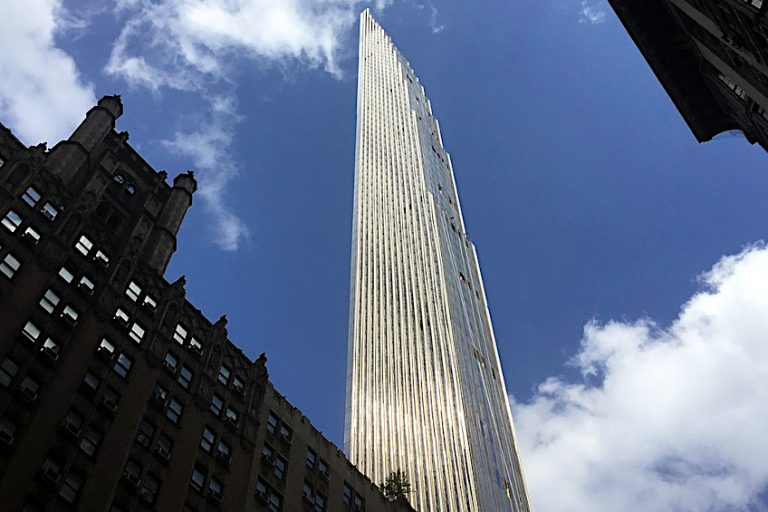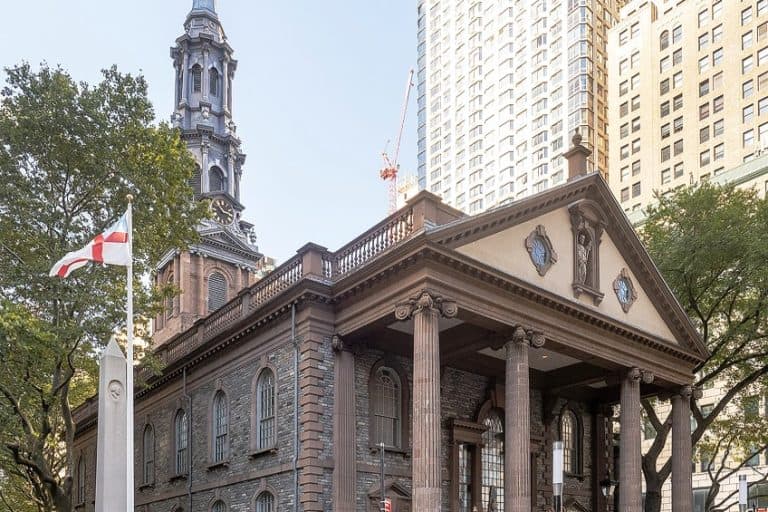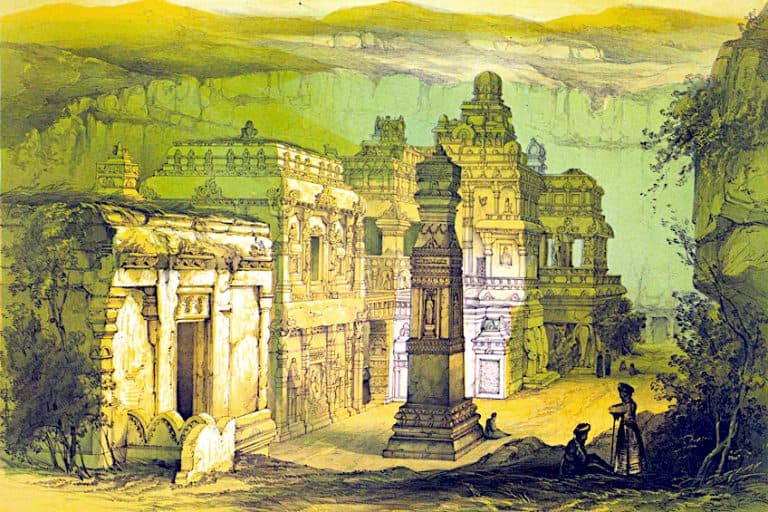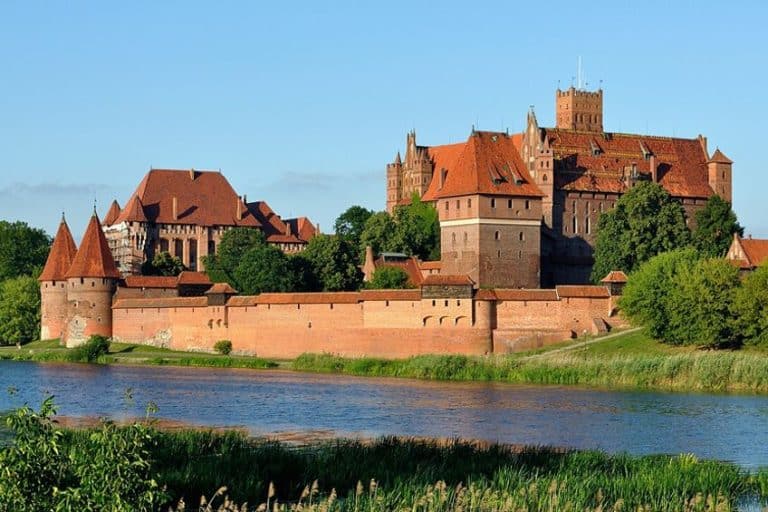Famous Cathedrals – Visiting the World’s Most Beautiful Churches
Famous cathedrals and their towering spires are among the most recognizable and prominent monuments in the world, rising spectacularly above the cities that surround them. The most beautiful cathedrals in the world serve as a sign of God’s great power and majesty for centuries, with some of the ancient cathedrals having been built thousands of years ago. The world’s most beautiful churches are mesmerizing places to visit, with stunning architecture, magnificent paintings, and stained-glass windows adorning the cathedral interiors. Let us go on a journey around the globe, as we explore the most beautiful churches in the world!
Exploring Famous Cathedrals
There is a multitude of reasons why you might be interested in exploring the most beautiful cathedrals in the world. The most beautiful churches in the world are inherently immersed in religious history and awe-inspiring architecture. Whatever your spiritual views, the world’s most beautiful churches are spectacular sites to see and will undoubtedly be a highlight of any vacation.
Many ancient cathedrals still exist today, since they have been in regular use throughout the centuries and many generations have maintained the cathedral interiors and facades.
The Most Beautiful Cathedrals in the World
The reason some of the most beautiful churches in the world are referred to as basilicas and others as cathedrals may be found in their purpose. The main church of a Catholic diocese is called a cathedral and serves as the archbishop’s or bishop’s main church. The Pope designates certain high-status churches as basilicas because of their unique theological, cultural, or historical value. These famous cathedrals are today recognized as some of the most magnificent artistic, structural, and historical landmarks in the whole world, and are well-liked by both worshipers and visitors.
Mezquita of Cordoba (Cordoba, Spain)
| Date Completed | 988 AD |
| Architect | Hernán Ruiz the Younger (1514 – 1569) |
| Architectural Style | Islamic |
| Location | Cordoba, Spain |
The Mezquita of Cordoba is unquestionably one of the best specimens of Moorish architecture and is truly a joy to visit. The vast prayer hall has beautiful geometric and floral patterns, as well as lovely arches and charming pillars because it was a mosque for a considerable portion of its history. Built in 784 AD, it was transformed into a church during the Reconquista, and in the 16th century, a Renaissance cathedral nave was built in the center of the expansive complex.
One of Andalusia’s most enticing sights is the Mezquita of Cordoba, which features exquisite mosaics, elaborate marble sculptures, and a wealth of beautiful calligraphy.
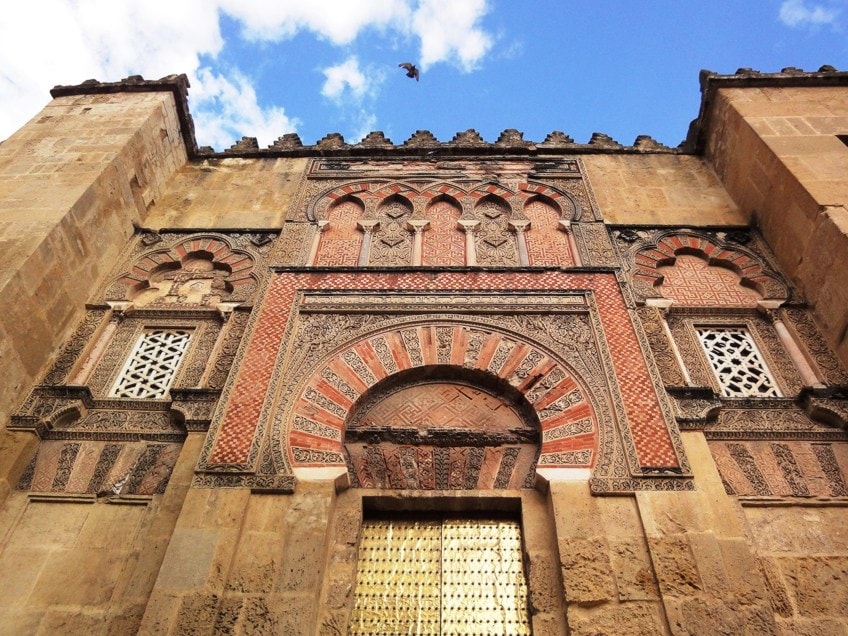
Prince Abd al-Rahman I fled to southern Spain after his family, the Umayyads, were overthrown by the advancing Abbasids in Damascus. Once there, he took over nearly the whole Iberian Peninsula and tried to make his new city, Cordoba, look as majestic as Damascus. He supported agriculture, financed extensive building projects, and even brought plants and fruit trees from his old residence. In the courtyard of the Mosque of Cordoba, orange trees still exist as a lovely, albeit sad, memory of the Umayyad exile.
Over the course of two centuries, the structure itself was extended.
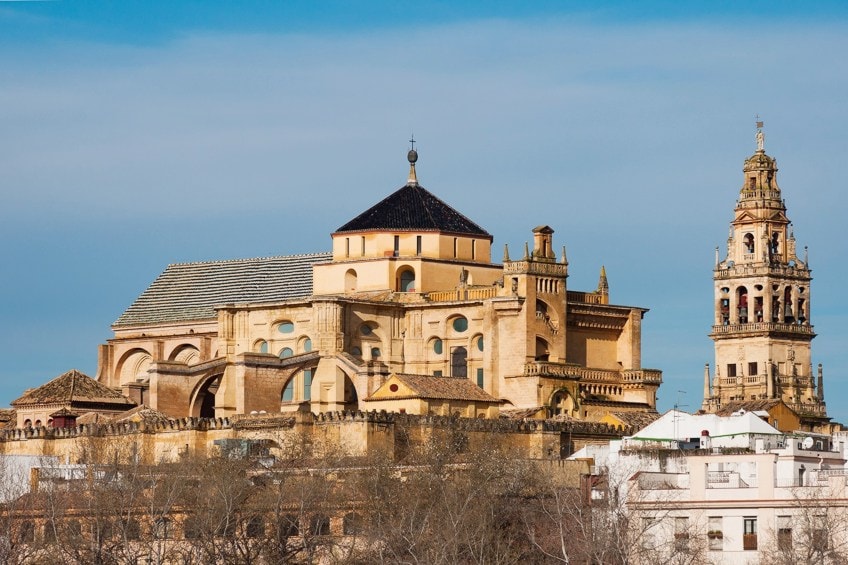
Its components include a sizable hypostyle prayer hall (hypostyle is Arabic for “packed with columns”), a courtyard with a fountain in the center, an orange grove, a covered walkway encircling the courtyard, and a former minaret that is now a square, tapering bell tower. The repetitive geometry of the large prayer hall seems to enlarge it.
It is constructed from salvaged Roman columns, from which two tiers of symmetrical arches made of stone and red brick emerge.
San Marco Basilica (Venice, Italy)
| Date Completed | 1094 |
| Architect | Domenico I Contarini (d. 1071) |
| Architectural Style | Byzantine |
| Location | Chartres, France |
This church, which stands where it does today, was presumably started in 1063 to reflect Venice’s burgeoning municipal pride. Its basis was the Church of the Holy Apostles in Constantinople from the sixth century, albeit modifications were made to the design to account for the site’s constraints and the unique requirements of Venetian state rituals.
Additionally, Romanesque and Islamic elements may be seen; and subsequently, Gothic features were added.
The initial brick facades and inner walls were adorned throughout time with priceless stones and rare marbles to represent the republic’s riches and authority, mostly in the 13th century. Due to the Venetian involvement in the Fourth Crusade, many of the columns, reliefs, and sculptures were looted from Constantinople’s temples, palaces, and civic monuments.
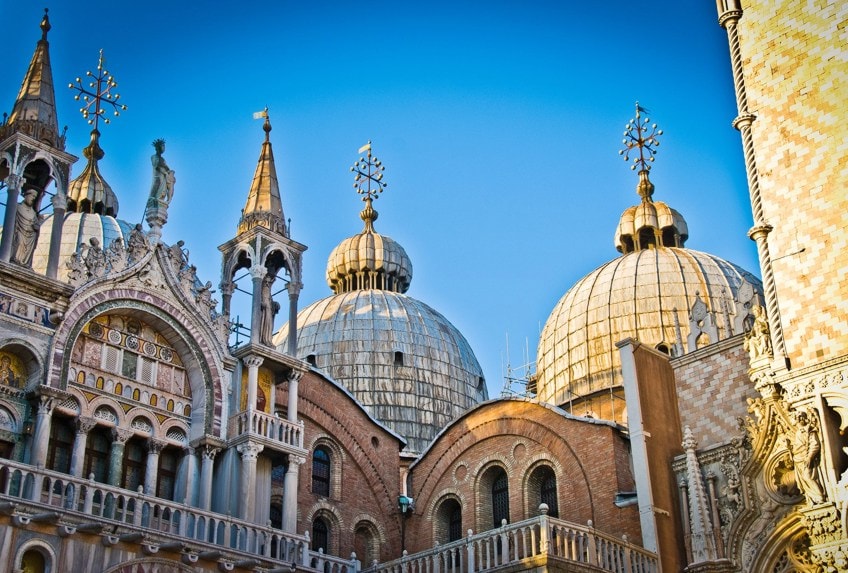
The four antique bronze horses that were conspicuously displayed over the entrance were one of the looted artifacts brought back to Venice. Gold-ground mosaics with prophets, saints, and biblical themes gradually filled the inside of the domes, vaults, and top walls. The mosaics reflect 800 years of creative styles, since many of these mosaics were subsequently repaired or recreated when artistic tastes evolved and broken mosaics needed to be replaced.
Some of them are masterpieces of medieval art derived from conventional Byzantine depictions, while others are based on preliminary sketches created by eminent Renaissance painters from Venice and Florence.
St. Stephen’s Cathedral (Vienna, Austria)
| Date Completed | 1137 |
| Architect | Anton Pilgram (1460 – 1516) |
| Architectural Style | Romanesque |
| Location | Vienna, Austria |
St. Stephen’s Cathedral, one of Vienna’s most iconic landmarks, is located at Stephansplatz. The cathedral, which exhibits exquisite Romanesque architecture, has a tall tower, gleaming limestone walls, and stunning roof mosaics that make it stand out. Visitors may explore the evocative catacombs and crypts within, which include the bones of significant Hapsburg dynasty members.
The church has been one of Vienna’s most striking historical and architectural icons ever since it was constructed in 1137.

Colorful roof tiles were used to build the coats of arms and the Royal and Imperial double-headed eagle on the roof of St. Stephen’s Cathedral in Vienna. All the way up to the Baroque era, the cathedral interiors saw several changes over the years.
The spectacular cathedral wealth, which includes relics adorned with precious stones, gold, religious texts, as well as garments, may be seen in conjunction with precious altars.
The St. Stephen’s Cathedral also served as the ultimate resting place for a number of notable individuals, including Emperor Friedrich III, who was interred in a magnificent marble sarcophagus. A private chapel serves as the ultimate resting place for Prince Eugene of Savoy. The Habsburg duke Rudolph IV, sometimes known as “the founder,” who lay the cornerstone for the Gothic renovation of the cathedral in 1359 is among the notable figures interred in the catacombs under St. Stephen’s Cathedral. The catacombs also include the tombs of Vienna’s archbishops and cardinals.
Chartres Cathedral (Chartres, France)
| Date Completed | 1252 |
| Architect | Master of Chartres (d. 1280) |
| Architectural Style | Gothic |
| Location | Chartres, France |
The majority of the original elements of the remarkably well-preserved Chartres Cathedral are still present. Its three amazing facades, vast, light-filled stained-glass windows, and enormous flying buttresses all date to circa 1220. Its facade is embellished with many sculptures and carvings portraying biblical events, making it a masterpiece of French Gothic architecture. The cathedral has long been a favorite with pilgrims and visitors since it is home to several significant graves and artifacts, while its ornate gateways and two towering spires are its most notable features.
Chartres Cathedral, a location of major architectural and historical importance, is located only to the southwest of Paris and is well worth exploring if you have the opportunity.
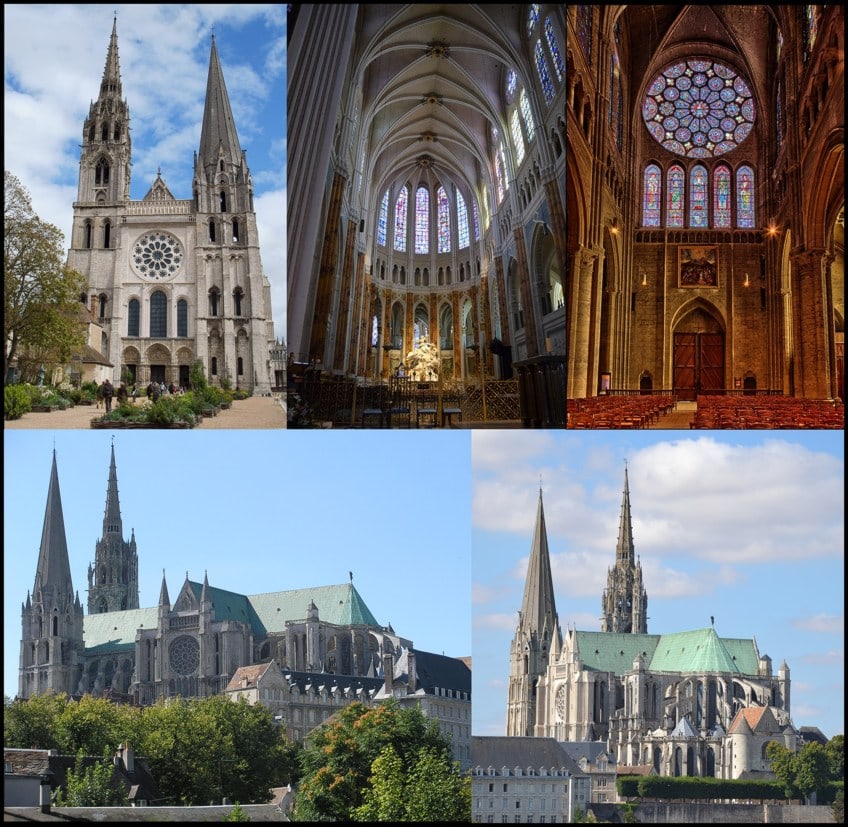
The Chartres Cathedral is the tallest point in this little town and the surrounding landscape. With its massive rock situated over a sea of rooftops and a vast area of land, Chartres is the highest note in its sphere of influence.
The fact that they had to climb a hill to get there, in the end, must have meant something to the pilgrims who came here.
Like other medieval cathedrals, the inside of Chartres exhibits verticality: the sheer height over the heads of the worshipers (or guests) contributes significantly to its awe. The windows of the Chartres Cathedral accentuate the interior’s verticality with their vivid pictures grouped in panels one above the other.
St. Vitus Cathedral (Prague, Czech Republic)
| Date Completed | 1344 |
| Architect | Peter Parler (1330 – 1399) |
| Architectural Style | Gothic |
| Location | Prague, Czech Republic |
Charles IV started building a Gothic church in 1344. The chancel, together with a circle of chapels was constructed by the church’s earliest builders, Matthias of Arras and subsequently Peter Parler. Parler had already begun building the South Tower, but he never saw it through to completion. It was completed in the 16th century with a Renaissance observation deck and a helmet. The earlier helmet was substituted with a new dome sometime in the 18th century. However, the Hussite Wars in 1419 caused the Cathedral’s construction to cease.
The restoration of the ancient component and construction of the Cathedral in the Neo-Gothic style did not start until the second half of the 19th century. In 1929, the church was formally dedicated. Even subsequent years saw modifications to its inside.

Through the doorway on the western facade, which is located across from the corridor connecting Prague Castle’s Second and Third Courtyards, guests enter the Cathedral. Reliefs depicting incidents from the Cathedral’s history as well as from the myths surrounding St. Wenceslas and St. Adalbert adorn the bronze entrance.
The main nave, the transverse nave’s northern wing, and the little side aisles flanked by chapels make up the cathedral’s Neo-Gothic section.
The Royal Mausoleum, which contains the royal crypt, is located in the cathedral’s chancel in front of the high altar. A circle of Gothic chapels surrounds the chancel. Saints and Czech monarchs are buried in several of them.
Santa Maria del Fiore (Florence, Italy)
| Date Completed | 1436 |
| Architect | Filippo Brunelleschi (1377 – 1446) |
| Architectural Style | Gothic |
| Location | Florence, Italy |
Since it was finished in 1436, Santa Maria del Fiore in Florence, one of the world’s most beautiful churches, has captivated and amazed observers. Its stunning Gothic Revival exterior, which was constructed using green, pink, and white marble, is covered with many exquisite carvings and sculptures, as well as three rose windows and three solid bronze doors. The magnificent structure has a massive red-tiled dome on top that can be seen from all across the city.
Despite the cathedral’s interior being very bare compared to its lavish facade, there are still some exquisite artworks and tombs for guests to admire.

The building’s wide variety of styles is evidence of how preferences have changed throughout the long span of time between its foundation and completion. On September 8, 1296, the first stone of the façade was set according to an Arnolfo di Cambio design. From 1296 until 1302, di Cambio worked on the cathedral. He created a basilica with classical dimensions centered on three broad aisles that converge in a large choir that houses the high altar and is encircled by tribunes before being topped with a dome.
As we can see from the outside, Di Cambio’s design was very different from the church’s current construction.
https://www.youtube.com/watch?v=ONaL9WUUInM
Saint John’s Co-Cathedral (Valletta, Malta)
| Date Completed | 1577 |
| Architect | Girolamo Cassar (1520 – 1592) |
| Architectural Style | Baroque |
| Location | Valletta, Malta |
This Roman Catholic cathedral honoring Saint John the Baptist is located in the center of Valletta. It is stunning and majestic. The Knights of Malta constructed it at Jean de la Cassière, the Grand Master’s request to serve as the Conventual Church of Saint John. Its structure is a magnificent representation of Baroque architecture, making it a must-see site on a vacation to Malta.
A number of priceless works of art, including paintings by the great Caravaggio and, presents from former Grand Masters and Knights of the Order of St. John, enhance the co-cathedral.

Its walls and ceilings are covered with shimmering gold decorations, and large marble tombstones are displayed alongside magnificent artworks and statues. Its nine chapels are equally ornamented, and the adjacent museum contains even more artifacts and riches. The interior of the cathedral was imbued with the Baroque style in the 17th century by Mattia Preti and other accomplished artisans.
The cathedral was further adorned over the years by numerous endowments and inheritances left by the successive Knights, making it a genuine treasure.
St. Paul’s Cathedral (London, England)
| Date Completed | 1697 |
| Architect | Christopher Wren (1632 – 1723) |
| Architectural Style | Renaissance |
| Location | London, England |
St. Paul’s Cathedral, one of the most well-known and identifiable monuments in London, and its enormous dome has dominated the city’s skyline ever since it was constructed back in 1697. With a gigantic dome that rises 111 meters high, St. Paul’s Basilica is a replica of St. Peter’s Basilica in the Vatican. In addition to this, there is a stunning Baroque front, shining marble flooring, and an incredible apse and altar within for tourists to admire.
It’s no surprise that St. Paul’s Cathedral is a well-liked tourist destination given the opulent tombs and sarcophagi of prominent British figures that can be seen there along with captivating paintings and sculptures.
With Palladio, Inigo Jones’ classical style, the baroque of Rome in the 17th century, and the structures by Mansart and others that he had seen in France as inspiration, Wren interpreted the customs of English medieval cathedrals in St. Paul’s Cathedral, which is constructed in a restrained Baroque style. St. Paul’s clearly displays influences from the Middle Ages, especially in its design. Similar to York’s and Winchester’s enormous medieval cathedrals, St. Paul’s is relatively long for its breadth and features dramatically projecting transepts.
It places a lot of attention on its facade, which was created to define the shape of the structure behind it rather than to hide it.

St. Patrick’s Cathedral (Manhattan, New York)
| Date Completed | 1879 |
| Architect | James Renwick Jr. (1818 – 1895) |
| Architectural Style | Gothic revival |
| Location | Manhattan, New York |
The history of New York’s famous cathedral reflects that of the whole city. St. Patrick’s Cathedral was erected in the democratic spirit, supported by the generosity of 103 notable residents who each donated $1,000, as well as by the donations of thousands of low-income immigrants. The church was created to demonstrate the advancement of religious equality and liberty. The adage “no generation builds a cathedral” is disproved by St. Patrick’s Cathedral. Instead, it’s more of an ongoing dialogue that connects the past, present, and future.
St. Patrick’s Cathedral’s foundation stone was placed in 1858, and its doors were first opened in 1879.

The announcement of Archbishop John Hughes’ innovative plan to construct the “new” St. Patrick’s Cathedral was made more than 160 years ago. Archbishop Hughes made the following request during a service at Old St. Patrick’s Cathedral: “For the honor of God Almighty, for the glory of the Graced and Impeccable Virgin, for the glorification of Holy Mother Church, for the integrity of our ancient and magnificent Catholic name, to establish a Cathedral in the City of New York that may be deserving of our expanding numbers, intellect, and affluence as a religious society, and at all occurrences, deserving as a community architectural monument, of this metropolis.”
Archbishop Hughes persevered in his audacious plan to construct the most wonderful Gothic Cathedral in the world in what he assumed would one day be “the center of the city,” despite it being ridiculed as folly because the proposed, nearly wilderness site was thought to be too far outside of the city.
The bloody Civil War and the ensuing scarcity of resources and labor would not prevent Hughes’ ambition and its audacious plan’s architect, James Renwick, from being realized in the end.
Cologne Cathedral (Cologne, Germany)
| Date Completed | 1880 |
| Architect | Master Gerhard (1210 – 1271) |
| Architectural Style | Gothic |
| Location | Cologne, Germany |
The center and defining feature of this Rhine-side city is the cathedral, a structure of unparalleled stature. On the 15th of August, 1248, on the Feast of the Assumption of Mary, the foundation of this Gothic cathedral was placed. The Three Wise Men’s relics, which Rainald von Dassel had delivered to Cologne from Milan when that city was captured in 1164, were previously housed in the preceding structure, but it appears that this edifice was no longer thought magnificent enough to hold their remains. The cathedral rose to prominence as one of Europe’s most significant sites of pilgrimage as a result of these artifacts.
Since their erection in 1880, its two enormous towers have dominated the skyline of the city. The northern tower is 7 cm higher than the southern one at 157.38 meters.

The cathedral’s construction really started in 1248, but it wasn’t fully finished until 1880. Amiens Cathedral served as a major inspiration for the cathedral’s architecture. The Cologne Cathedral, with its stunning Gothic architecture and vantage point over the Rhine, is the most popular tourist destination in all of Germany. The cathedral is currently Cologne’s second-tallest building, behind only the communications tower in height. The cathedral has a floor area of about 8,000 square meters and can accommodate more than 20,000 people.
In 1996, UNESCO designated Cologne Cathedral as a World Heritage Site because of the structure’s magnificent Gothic architecture, the monument to the Three Wise Men, the exceptional stained-glass windows, and numerous other significant works of art.
Alexander Nevsky Cathedral (Sofia, Bulgaria)
| Date Completed | 1912 |
| Architect | Alexander Pomerantsev (1849 – 1918) |
| Architectural Style | Byzantine revival |
| Location | Sofia, Bulgaria |
The magnificent Neo-Byzantine Alexander Nevsky Cathedral, one of the biggest Orthodox churches in the world, is a prominent landmark and a representation of Sofia. The enormous cathedral, which was constructed between 1882 and 1912, was built as a memorial to the Russian troops who lost their lives freeing Bulgaria from the Ottomans. While its glittering exterior and gold-plated dome make for some lovely photographs, its spacious and subdued interior is as alluring as the bright symbols that cover its walls.
The St. Alexander Nevsky Cathedral’s construction began in 1882 when the foundation stone was set, although most of it was constructed between 1904 and 1912.

The original 1884 to 1885 proposal of Ivan Bogomolov was drastically altered by Alexander Pomerantsev, with assistance from Alexander Smirnov and Alexander Yakovlev. A group of artists, architects, and laborers from Bulgaria, Russia, Austria-Hungary, and other European countries, along with the abovementioned architects, completed the final design in 1898.
The metal components for the gates were made in Berlin, the marble components and lighting fixtures in Munich, the gates themselves in Karl Bamberg’s foundry in Vienna, and the mosaics were imported from Venice.
Catedral Basílica Del Pilar (Zaragoza, Spain)
| Date Completed | 1961 |
| Architect | Ventura Rodriguez (1717 – 1785) |
| Architectural Style | Rococo |
| Location | Zaragoza, Spain |
Local legends date the foundation of this basilica to the early days of Christianity in Spain and attribute an appearance to Saint James the Great who is credited with introducing the religion to the nation. Only this apparition of Mary is known to have taken place prior to her alleged Assumption. One of Zaragoza’s most well-known tourist destinations is the Cathedral, which was constructed in a stunning Baroque style.
Even though it was only constructed in 1681, the location has seen the construction of countless churches and chapels ever since the Mother of God was reportedly seen on the riverbank of the Ebro in 40 AD.
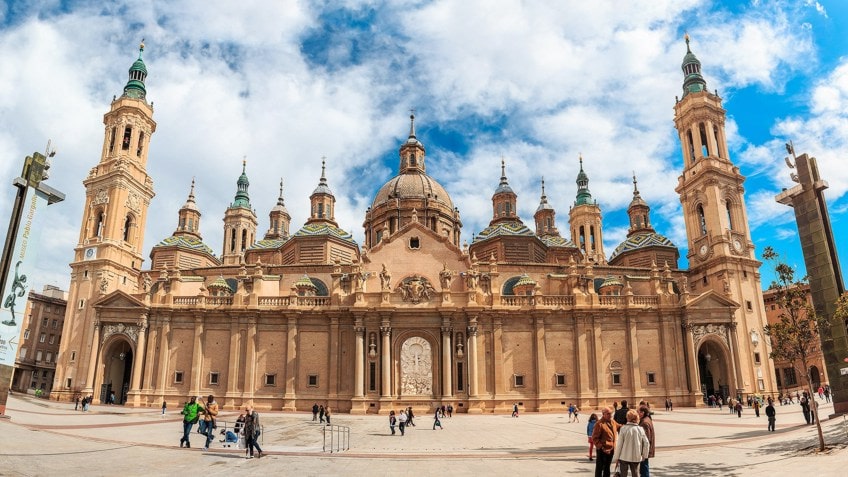
Ancient local legend claims that Saint James preached the gospel in Spain immediately after Jesus was crucified and resurrected, but was discouraged by the outcome of his mission. According to legend, the Mother of God appeared to him when he was in intense devotion by the banks of the Ebro, handed him a column of jasper, and gave him the order to erect a cathedral in her honor.
The cathedral’s magnificent exterior is capped with a variety of charming cupolas that surround its main dome.
The structure, which is visible from the neighboring Ebro River, is a sizable rectangle with two aisles, a nave, and two additional chapels made entirely of brick, giving the whole a distinctively Aragonese feel. Large oculi that are typical of the monuments in the area from the 17th century onward illumine it. The aisles and naves are vaulted, supported by 12 colossal pillars, and both the chapels and the entire structure are crowned with domes.
Cathedral of Brasilia (Brasilia, Brazil)
| Date Completed | 1970 |
| Architect | Oscar Niemeyer (1907 – 2012) |
| Architectural Style | Futurist |
| Location | Brasilia, Brazil |
The Cathedral of Brasilia was created by Oscar Niemeyer, the most well-known architect in Brazil, and is renowned for its distinctive and eccentric style. The 1970-completed cathedral is supported by 16 strong columns that softly curve into one another. These are intended to resemble two hands extending upward. In the cathedral, statues of angels swirl over the pulpits, and the majority of the walls are made of magnificent stained glass windows. Four sculptures of Mark, Matthew, Luke, and John greet visitors to the unusual cathedral. Niemeyer wanted to produce a book that, regardless of viewpoint, had the same level of “purity.”
The Cathedral of Brasilia is a hyperbolic building that resembles a crown and seems to be fastened to the earth. Both the building’s outside, with its unique design and stunning stained-glass ceiling, and its interior is fascinating.
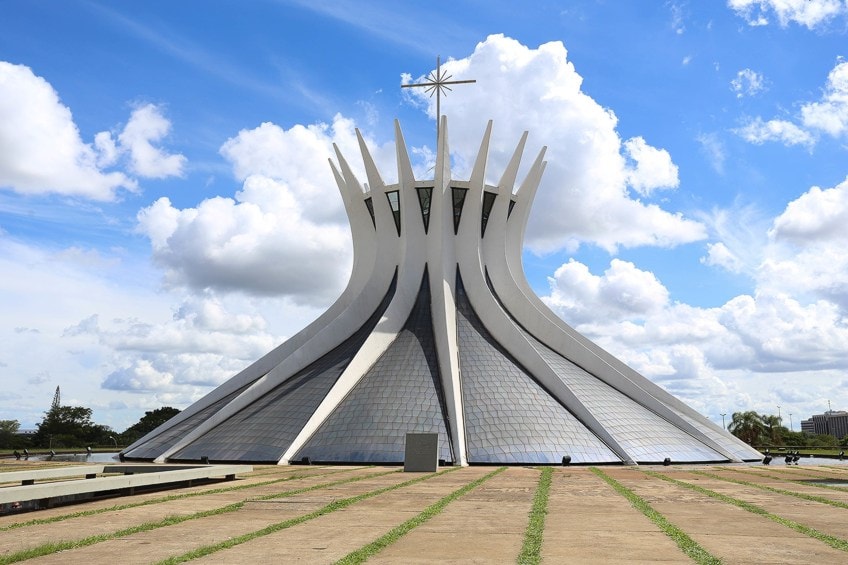
In September 1958, the Cathedral of Brasilia’s foundation stone was placed. Two years later, the cathedral’s basic structure was finished, but like with many other construction projects in Brasilia at the time, everything came to a total stop. When his tenure as president concluded in 1961, President Juscelino Kubitschek was in charge of the building of Brasilia, Brazil’s new capital. Many developments, including the cathedral, experienced construction snags.
Despite Kubitschek’s original plan to build a state-funded, interdenominational cathedral accessible to all religions, the cathedral was given to the Catholic Church in order to get things rolling again.
Zipaquira Salt Cathedral (Zipaquira, Columbia)
| Date Completed | 1995 |
| Architect | Roswell Garavito Pearl (b. 1915) |
| Architectural Style | Stereotomic |
| Location | Zipaquira, Columbia |
Situated in the bowels of the mines in the Cundinamarca region, the church made of salt has a large art collection, primarily statues made of marble and salt. The fact that each piece has a Catholic religious significance is what attracts so many travelers to it.
Many individuals go to the Zipaquirá Salt Cathedral to give gratitude or to make a specific request to God.
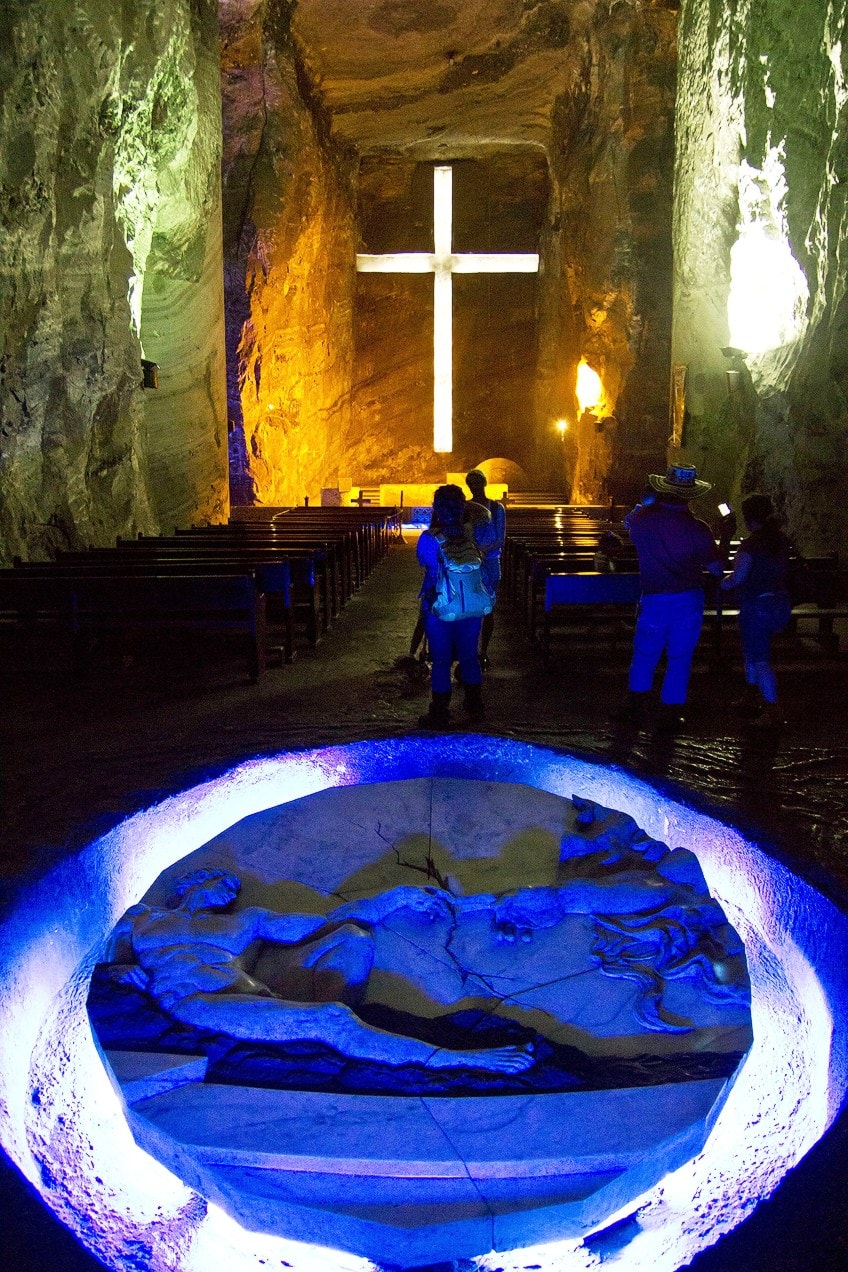
The piece of art that best captures the intricate cultural complex’s appeal is its underground chapel. The sacral axis, which houses a gigantic salt cross with lovely lighting that creates a visual impact on the cross’s actual construction, is another significant location within the salt cathedral.
Zipaquira Salt Cathedral, a truly amazing destination to see, is located 200 meters below ground.
The cathedral is built on three floors and was hewn out of a single piece of solid rock, displaying exquisitely carved sculptures and icons. These stand in for Jesus’ conception, early life, and death. The salt cathedral, an astounding architectural feat outside the Colombian city of Zipaquira, is today a well-liked tourist and pilgrimage destination.
The Cathedral boasts Colombia’s biggest climbing wall outside; it is both an adrenaline rush and a dizzying experience. You may also choose to board the Zipaquirá tourist train, which will take you on a tour of the region’s most stunning landscapes. As you ride, you can sample delectable foods and treats that train staff will demonstrate with a delightful culinary performance.
That concludes our look at some of the most beautiful cathedrals in the world. From ancient cathedrals to those created in the previous century, these famous cathedrals all encompass beauty and majesty on a massive scale. Cathedrals are among the most impressive architectural marvels in both religion and world history. It is not necessary to identify as spiritual in order to appreciate the benefit of visiting these historical locations. Their meticulously painted frescoes and intricately carved steeples recount the history of the location and shed light on its neighborhood.
Take a look at our most famous cathedrals webstory here!
Frequently Asked Questions
What Are Common Characteristics of the Most Beautiful Churches in the World?
The world’s most stunning churches are inextricably bound up with a rich religious past and stunning construction. Regardless of your religious beliefs, visiting one of the world’s most stunning churches is unquestionably one of the highlights of any trip. Since they have been in continuous use for so long and so many generations have taken care of maintaining the cathedral interiors and facade, many historic cathedrals still stand today.
Is There a Difference Between a Cathedral and a Basilica?
A cathedral is the major church of a Catholic diocese and serves as the archbishop’s or bishop’s principal church. Because of their particular theological, cultural, or historical worth, the Pope recognizes some high-status churches as basilicas. These great cathedrals are now considered among the world’s most stunning artistic, structural, and historical landmarks, and are popular with both worshipers and visitors.
Justin van Huyssteen is a freelance writer, novelist, and academic originally from Cape Town, South Africa. At present, he has a bachelor’s degree in English and literary theory and an honor’s degree in literary theory. He is currently working towards his master’s degree in literary theory with a focus on animal studies, critical theory, and semiotics within literature. As a novelist and freelancer, he often writes under the pen name L.C. Lupus.
Justin’s preferred literary movements include modern and postmodern literature with literary fiction and genre fiction like sci-fi, post-apocalyptic, and horror being of particular interest. His academia extends to his interest in prose and narratology. He enjoys analyzing a variety of mediums through a literary lens, such as graphic novels, film, and video games.
Justin is working for artincontext.org as an author and content writer since 2022. He is responsible for all blog posts about architecture, literature and poetry.
Learn more about Justin van Huyssteen and the Art in Context Team.
Cite this Article
Justin, van Huyssteen, “Famous Cathedrals – Visiting the World’s Most Beautiful Churches.” Art in Context. August 2, 2022. URL: https://artincontext.org/famous-cathedrals/
van Huyssteen, J. (2022, 2 August). Famous Cathedrals – Visiting the World’s Most Beautiful Churches. Art in Context. https://artincontext.org/famous-cathedrals/
van Huyssteen, Justin. “Famous Cathedrals – Visiting the World’s Most Beautiful Churches.” Art in Context, August 2, 2022. https://artincontext.org/famous-cathedrals/.




